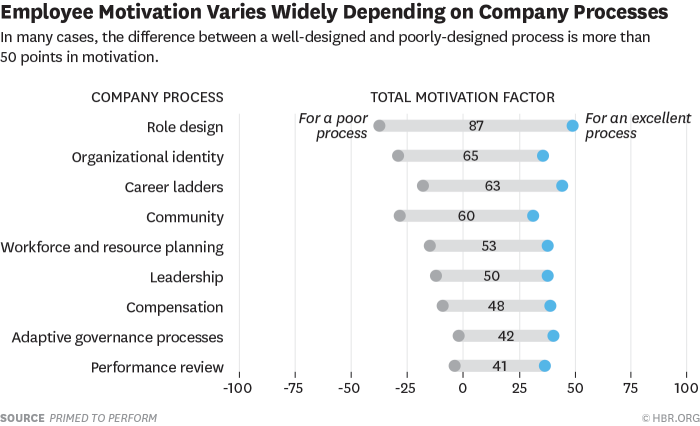Article Breakdown
Why we work determines how well we work:
Researchers asked almost 2,500 workers to analyze medical images for “objects of interest.” They told one group that the work would be discarded; they told the other group that the objects were “cancerous tumor cells.” The workers were paid per image analyzed. The latter group, or “meaning” group, spent more time on each image, earning 10% less, on average, than the “discard” group — but the quality of their work was higher. Reshaping the workers’ motive resulted in better performance (Journal of Economic Behaviour @ Organization).
The six main reasons why people work, based on Breakthrough research from the 1980’s, were built on and adapted for the modern framework. Researchers found that 3 tend to increase performance, whilst three tend to hurt it:
Performance increasing reasons why we work:
Play – when motivated by the work itself. It is our learning instinct, tied to curiosity, experimentation, and exploring challenging problems.
Purpose – the outcome of work fits your identity. You value the work’s impact.
Potential – the outcome of work benefits your identity.
This benefits your potential. These are direct motives, as they are directly connected to the work itself.
Performance hurting reasons why we work:
Emotional pressure – working because an external force threatens your identity. Fear, peer pressure, and shame are all forms of this.
Economic – working to gain reward or avoid punishment.
Inertia – the motive for work is so far removed from the work and your identity. You have no idea why you are doing the work.
These are indirect motives.
These are indirect motives, as they are not directly connected to the work itself.
Higher customer satisfaction is linked to stronger workplace cultures:
Cultures that inspire more play, purpose and potential, and less emotional pressure, economic pressure, and inertia, produce better customer outcomes. This is consistent across retail, banking, telecommunications, fast food, groceries and the airline industry.
Employee motivation
Role Design linked to play
Toyota – give factory workers the opportunity to come up with and test new tools and ideas on the assembly line.
Southwest Airlines – encourage their people to treat each customer interaction as play. This has seen flight staff turning boring announcements into comedy sketches.
Organisational Identity linked to purpose
UCB Pharmaceuticals – invite patients to executive meetings so the people making decisions can see how their work makes a difference.
Walmart – management meetings kicked off by reviewing how much money the division has saved customers rather than how much money Walmart has made.
Career Ladder linked to emotional and economic pressure
Systems where employees are stack-ranked or rated against each other increase emotional and economic pressure, reducing total motivation and thus performance.
As a result, many companies, including Microsoft, are moving away from performance review systems that foster unhealthy competition.
What leaders can do
Senior Leaders can build and maintain a high-performing culture by teaching managers to lead in highly motivating ways.
One study of bank branch managers showed that offering high-ToMo (TotalMotivation) leadership training led to a 20% increase in credit card sales and a 47% increase in personal loan sales.
CEOs should make a business case for culture (with a budget) and enlist HR and business leaders to improve the elements that affect culture, from role design to performance reviews.
Our thoughts on this
We love being motivated! But that’s not all…
So purpose is a contributor to company culture, and company culture fuels motivation. But it is a Managers job to fuel this purpose and bring it to life for their employees. This is done through understanding what gives their employees purpose, coaching, and acknowledgement of when purpose has lead to results. We’ve all been in a position where we’ve worked really hard on a particular task only for it to be overlooked, undone or unutilised. And it sucks! So as a Manager, start thinking about how you can be Mr (or Mrs) Motivator.
Here are two brilliant readings that will help you:
A big part of a company culture is how purpose is consistently created for employees within their role. It is also essential to emotionally connect employees to the company brand. Continually enabling them to understand the purpose of the organisation as well as where and how they fit within it.
Employees must deliver on every promise a brand markets externally to its customers, across all functions. This means that all internal processes and functions must be aligned to the external brand promise. We call this Brand Internalisation. And it is the combined effort of both Marketing and HR.
So we’ve loaded you with plenty of reading, loads of thoughts, and hopefully mountains of motivation to motivate.
But if you want more:
Download our whitepaper on how to create a highly motivating culture through brand aligned purpose, and people managers redesigning performance reviews, all in the context of the millennial, who are rapidly taking over the workplace.

